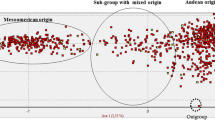Summary
Allozyme analysis was performed on 83 wild Phaseolus vulgaris accessions, representing a wide geographical distribution from Mesoamerica to Argentina, to determine levels of genetic diversity and geographic patterns of variability at nine polymorphic isozyme loci. The collection can be divided into two major groups, one consisting of accessions from Mexico, Central America, Colombia and Peru, and the other consisting of accessions from Peru and Argentina. One accession from northern Peru is distinct from the two major groups, and may delineate a transition zone between the two divergent groups. The level of genetic diversity within wild P. vulgaris (Ht=0.132) is comparable with those found in other Phaseolus species. There was no significant within-accession gene diversity (Hs=0.006); however, there is a moderate level of genetic diversity (Dst=0.126) between accessions. Our results are consistent with previous studies on the genetic diversity of wild P. vulgaris using phaseolin, the major seed storage protein of beans.
Similar content being viewed by others
References
Bassiri A, Adams MW (1978a) An electrophoretic survey of seeding isozymes in several Phaseolus species. Euphytica 27:447–459
Bassiri A, Adams MW (1978b) Evaluation of common bean cultivar relationships by means of isozyme electrophoretic patterns. Euphytica 27:707–720
Brewer GJ (1970) Introduction to isozyme techniques. Academic Press, New York
Brown AHD (1979) Enzyme polymorphism in plant populations. Theor Popul Biol 15:1–42
Brücher H (1988) The wild ancestor of Phaseolus vulgaris in the Andes. In: Gepts P (ed) Genetic resources, domestication and evolution of phaseolus beans. Kluwer, Dordrecht, pp 185–214
Burkart A (1941) Sobre la existencia de razas silvestres de Phaseolus vulgaris. Resol y Trab I Reun Argent Agron, Buenos Aires
Burkart A (1943) Las leguminosas argentinas silvestres y cultivadas. Acme, Buenos Aires
Cardy BJ, Stuber CW, Goodman MM (1980) Techniques for starch gel electrophoresis of enzymes from maize (Zea mays L.) Department of Statistics Mimeo Series No. 1317, North Carolina State University, Raleigh
Delgado A, Bonet A, Gepts P (1988) The wild ancestor of Phaseolus vulgaris in Mexico. In: Gepts P (ed) Genetic resources, domestication and evolution of Phaseolus beans. Kluwer, Dordrecht, pp 163–184
Gentry HS (1969) Origin of the common bean, Phaseolus vulgaris. Econ Bot 23:55–69
Gepts P (1987) Characterizing plant phenology: Growth and development scales. In: Wisiol K, Hesketh J (eds) Plant growth modeling for resource management, vol II, Quantifying plant processes. CRC Press, Boca Raton, pp 3–24
Gepts P (1988) Phaseolin as an evolutionary marker. In: Gepts P (ed) Genetic resources, domestication and evolution of Phaseolus beans. Kluwer, Dordrecht, pp 215–241
Gepts P, Bliss FA (1985) F1 hybrid weakness in the common bean: Differential geographic origin suggests two gene pools in cultivated germplasm. J Hered 76:447–450
Gepts P, Bliss FA (1986) Phaseolin variability among wild and cultivated common bean (Phaseolus vulgaris) from Colombia. Econ Bot 40:469–478
Gepts P, Osborn TC, Rashka K, Bliss FA (1986) Phaseolin protein variability in wild forms and landraces of the common bean (Phaseolus vulgaris); evidence for multiple centers of domestication. Econ Bot 40:451–468
Gottlieb LD (1981) Electrophoretic evidence in plant populations. Prog Phytochem 7:1–46
Hamrick JL (1983) The distribution of genetic variation within and among natural plant populations. In: Schonewald-Cox CM, Chambers SM, MacBryde B, Thomas L (eds) Genetics and conservation. Benjamin-Cummings, Menlo Park, pp 335–448
Hamrick JL, Linhart YB, Mitton JB (1979) Relationships between life history characteristics and electrophoretically detectable genetic variation in plants. Annu Rev Ecol Syst 10:173–200
Jaaska V, Jaaska V (1988) Isoenzyme variation in the genera Phaseolus and Vigna (Fabaceae) in relation to their systematics: Aspartate aminotransferase and superoxide dismutase. Plant Syst Evol 159:145–159
Koenig R, Gepts P (1989) Segregation and linkage of genes for seed proteins, isozymes, and morphological traits in common bean (Phaseolus vulgaris). J Hered (in press)
Koenig R, Singh S, Gepts P (1990) Novel phaseolin types in wild and cultivated common bean (Phaseolus vulgaris, Fabaceae). Econ Bot (in press)
Loveless MD, Hamrick JL (1984) Ecological determinants of genetic structure in plant populations. Annu Rev Ecol Syst 15:65–95
McBryde FW (1947) Cultural and historical geography of southwest Guatemala. Smithsonian Institute, Inst. Soc Anthrop Publ 4:35, 75–76, 134–135
Miranda Colín S (1967) Origen de Phaseolus vulgaris L. (frijol común). Agrociencia 1:99–109
Miranda Colín S (1979) Evolución de Phaseolus vulgaris y P. coccineus. In: Engleman M (ed) Contribuciones al conocimiento del frijol (Phaseolus) en México. Colegio de Postgraduados, Chapingo, pp 227
Nei M (1973) Analysis of gene diversity in subdivided populations. Proc Natl Acad Sci USA 70:3321–3323
Selander RK, Smith MH, Yang SY, Johnson WE, Gentry JB (1971) Biochemical polymorphism and systematics in the genus Peromyscus I. Variation in the old field mouse (Peromyscus polionotus). University Texas Publishers 7103:49–90
Shaw CR, Prasad R (1970) Starch gel electrophoresis a compilation of recipes. Biochem Genet 4:297–320
Singh SP, Gutierrez AJ (1984) Geographical distribution of the DL1 and DL2 genes causing hybrid dwarfism in Phaseolus vulgaris L., their association with seed size, and their significance to breeding. Euphytica 33:337–45
Sneath PHA, Sokal R (1973) Numerical taxonomy. Freeman, San Francisco
Sprecher SL (1988) Allozyme differentiation between gene pools in common bean (Phaseolus vulgaris L.), with special reference to Malawian germplasm. PhD thesis, Michigan State University, East Lansing (UMI, Diss. Inform. Serv. 8900102)
Vallejos E (1983) Enzyme activity staining. In: Tanksley SD, Orton TJ (eds) Isozymes in plant genetics and breeding. Elsevier, Amsterdam, pp 469–516
Wall JR, Wall SW (1975) Isozyme polymorphisms in the study of evolution in the Phaseolus vulgaris-P. coccineus complex of Mexico. In: Market CL (ed) Isozymes IV. Academic Press, New York
Weeden NF (1984a) Linkage between the gene coding for the small unit of ribulose bisphosphate carboxylase and the gene coding for malic enzyme in Phaseolus vulgaris. Annu Rep Bean Impr Coop 27:123–124
Weeden NF (1984b) Distinguishing among white-seeded bean cultivars by means of allozyme genotypes. Euphytica 33:199–208
Weeden NF (1986) Genetic confirmation that the variation in the zymograms of 3 enzyme systems is produced by allelic polymorphism. Annu Rep Bean Impr Coop 29:117–118
Weeden NF, Liang CY (1985) Detection of a linkage between flower color and Est-2 in common bean. Annu Rep Bean Impr Coop 27:87–88
Author information
Authors and Affiliations
Additional information
Communicated by A.L. Kahler
Rights and permissions
About this article
Cite this article
Koenig, R., Gepts, P. Allozyme diversity in wild Phaseolus vulgaris: further evidence for two major centers of genetic diversity. Theoret. Appl. Genetics 78, 809–817 (1989). https://doi.org/10.1007/BF00266663
Received:
Accepted:
Issue Date:
DOI: https://doi.org/10.1007/BF00266663




